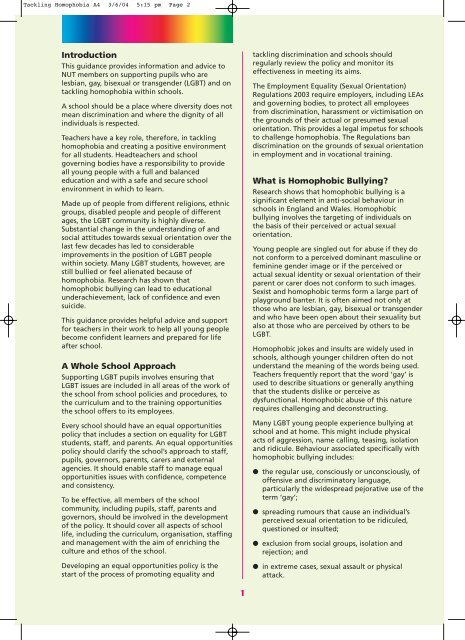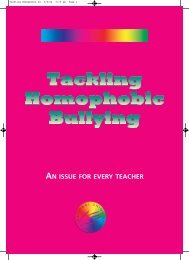Non-Normative Gender and Sexual Identities in Schools: - Schools Out
Non-Normative Gender and Sexual Identities in Schools: - Schools Out
Non-Normative Gender and Sexual Identities in Schools: - Schools Out
Create successful ePaper yourself
Turn your PDF publications into a flip-book with our unique Google optimized e-Paper software.
Tackl<strong>in</strong>g Homophobia A4 3/6/04 5:15 pm Page 2<br />
Introduction<br />
This guidance provides <strong>in</strong>formation <strong>and</strong> advice to<br />
NUT members on support<strong>in</strong>g pupils who are<br />
lesbian, gay, bisexual or transgender (LGBT) <strong>and</strong> on<br />
tackl<strong>in</strong>g homophobia with<strong>in</strong> schools.<br />
A school should be a place where diversity does not<br />
mean discrim<strong>in</strong>ation <strong>and</strong> where the dignity of all<br />
<strong>in</strong>dividuals is respected.<br />
Teachers have a key role, therefore, <strong>in</strong> tackl<strong>in</strong>g<br />
homophobia <strong>and</strong> creat<strong>in</strong>g a positive environment<br />
for all students. Headteachers <strong>and</strong> school<br />
govern<strong>in</strong>g bodies have a responsibility to provide<br />
all young people with a full <strong>and</strong> balanced<br />
education <strong>and</strong> with a safe <strong>and</strong> secure school<br />
environment <strong>in</strong> which to learn.<br />
Made up of people from different religions, ethnic<br />
groups, disabled people <strong>and</strong> people of different<br />
ages, the LGBT community is highly diverse.<br />
Substantial change <strong>in</strong> the underst<strong>and</strong><strong>in</strong>g of <strong>and</strong><br />
social attitudes towards sexual orientation over the<br />
last few decades has led to considerable<br />
improvements <strong>in</strong> the position of LGBT people<br />
with<strong>in</strong> society. Many LGBT students, however, are<br />
still bullied or feel alienated because of<br />
homophobia. Research has shown that<br />
homophobic bully<strong>in</strong>g can lead to educational<br />
underachievement, lack of confidence <strong>and</strong> even<br />
suicide.<br />
This guidance provides helpful advice <strong>and</strong> support<br />
for teachers <strong>in</strong> their work to help all young people<br />
become confident learners <strong>and</strong> prepared for life<br />
after school.<br />
A Whole School Approach<br />
Support<strong>in</strong>g LGBT pupils <strong>in</strong>volves ensur<strong>in</strong>g that<br />
LGBT issues are <strong>in</strong>cluded <strong>in</strong> all areas of the work of<br />
the school from school policies <strong>and</strong> procedures, to<br />
the curriculum <strong>and</strong> to the tra<strong>in</strong><strong>in</strong>g opportunities<br />
the school offers to its employees.<br />
Every school should have an equal opportunities<br />
policy that <strong>in</strong>cludes a section on equality for LGBT<br />
students, staff, <strong>and</strong> parents. An equal opportunities<br />
policy should clarify the school’s approach to staff,<br />
pupils, governors, parents, carers <strong>and</strong> external<br />
agencies. It should enable staff to manage equal<br />
opportunities issues with confidence, competence<br />
<strong>and</strong> consistency.<br />
To be effective, all members of the school<br />
community, <strong>in</strong>clud<strong>in</strong>g pupils, staff, parents <strong>and</strong><br />
governors, should be <strong>in</strong>volved <strong>in</strong> the development<br />
of the policy. It should cover all aspects of school<br />
life, <strong>in</strong>clud<strong>in</strong>g the curriculum, organisation, staff<strong>in</strong>g<br />
<strong>and</strong> management with the aim of enrich<strong>in</strong>g the<br />
culture <strong>and</strong> ethos of the school.<br />
Develop<strong>in</strong>g an equal opportunities policy is the<br />
start of the process of promot<strong>in</strong>g equality <strong>and</strong><br />
tackl<strong>in</strong>g discrim<strong>in</strong>ation <strong>and</strong> schools should<br />
regularly review the policy <strong>and</strong> monitor its<br />
effectiveness <strong>in</strong> meet<strong>in</strong>g its aims.<br />
The Employment Equality (<strong>Sexual</strong> Orientation)<br />
Regulations 2003 require employers, <strong>in</strong>clud<strong>in</strong>g LEAs<br />
<strong>and</strong> govern<strong>in</strong>g bodies, to protect all employees<br />
from discrim<strong>in</strong>ation, harassment or victimisation on<br />
the grounds of their actual or presumed sexual<br />
orientation. This provides a legal impetus for schools<br />
to challenge homophobia. The Regulations ban<br />
discrim<strong>in</strong>ation on the grounds of sexual orientation<br />
<strong>in</strong> employment <strong>and</strong> <strong>in</strong> vocational tra<strong>in</strong><strong>in</strong>g.<br />
What is Homophobic Bully<strong>in</strong>g?<br />
Research shows that homophobic bully<strong>in</strong>g is a<br />
significant element <strong>in</strong> anti-social behaviour <strong>in</strong><br />
schools <strong>in</strong> Engl<strong>and</strong> <strong>and</strong> Wales. Homophobic<br />
bully<strong>in</strong>g <strong>in</strong>volves the target<strong>in</strong>g of <strong>in</strong>dividuals on<br />
the basis of their perceived or actual sexual<br />
orientation.<br />
Young people are s<strong>in</strong>gled out for abuse if they do<br />
not conform to a perceived dom<strong>in</strong>ant mascul<strong>in</strong>e or<br />
fem<strong>in</strong><strong>in</strong>e gender image or if the perceived or<br />
actual sexual identity or sexual orientation of their<br />
parent or carer does not conform to such images.<br />
Sexist <strong>and</strong> homophobic terms form a large part of<br />
playground banter. It is often aimed not only at<br />
those who are lesbian, gay, bisexual or transgender<br />
<strong>and</strong> who have been open about their sexuality but<br />
also at those who are perceived by others to be<br />
LGBT.<br />
Homophobic jokes <strong>and</strong> <strong>in</strong>sults are widely used <strong>in</strong><br />
schools, although younger children often do not<br />
underst<strong>and</strong> the mean<strong>in</strong>g of the words be<strong>in</strong>g used.<br />
Teachers frequently report that the word ‘gay’ is<br />
used to describe situations or generally anyth<strong>in</strong>g<br />
that the students dislike or perceive as<br />
dysfunctional. Homophobic abuse of this nature<br />
requires challeng<strong>in</strong>g <strong>and</strong> deconstruct<strong>in</strong>g.<br />
Many LGBT young people experience bully<strong>in</strong>g at<br />
school <strong>and</strong> at home. This might <strong>in</strong>clude physical<br />
acts of aggression, name call<strong>in</strong>g, teas<strong>in</strong>g, isolation<br />
<strong>and</strong> ridicule. Behaviour associated specifically with<br />
homophobic bully<strong>in</strong>g <strong>in</strong>cludes:<br />
● the regular use, consciously or unconsciously, of<br />
offensive <strong>and</strong> discrim<strong>in</strong>atory language,<br />
particularly the widespread pejorative use of the<br />
term ‘gay’;<br />
● spread<strong>in</strong>g rumours that cause an <strong>in</strong>dividual’s<br />
perceived sexual orientation to be ridiculed,<br />
questioned or <strong>in</strong>sulted;<br />
● exclusion from social groups, isolation <strong>and</strong><br />
rejection; <strong>and</strong><br />
● <strong>in</strong> extreme cases, sexual assault or physical<br />
attack.<br />
1







